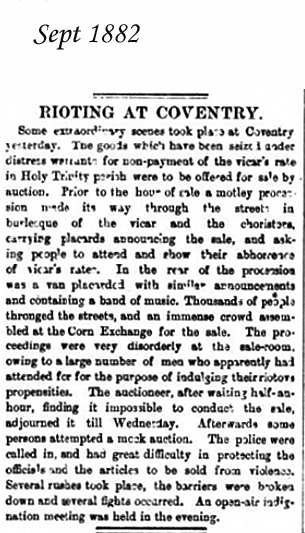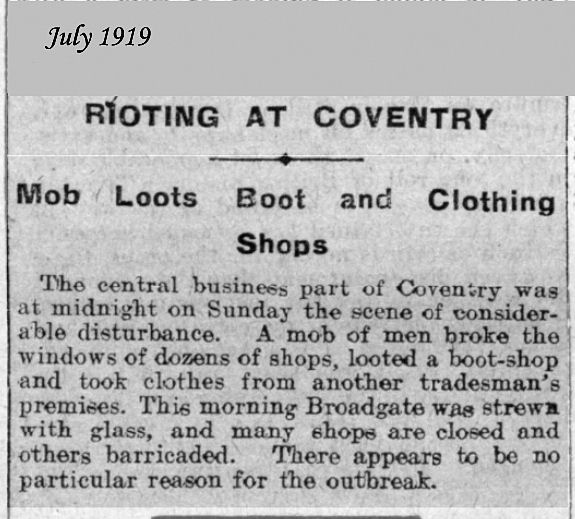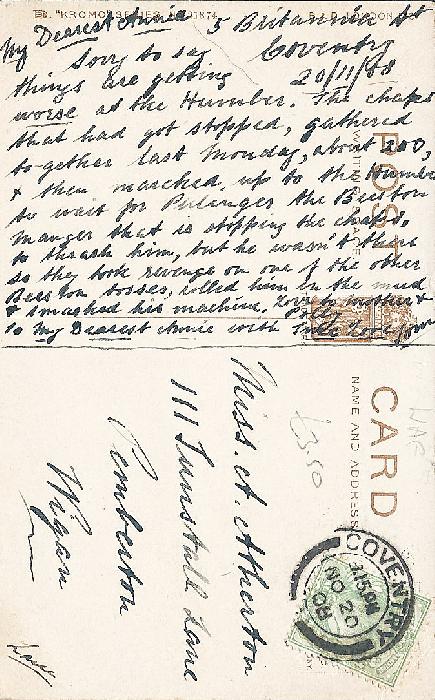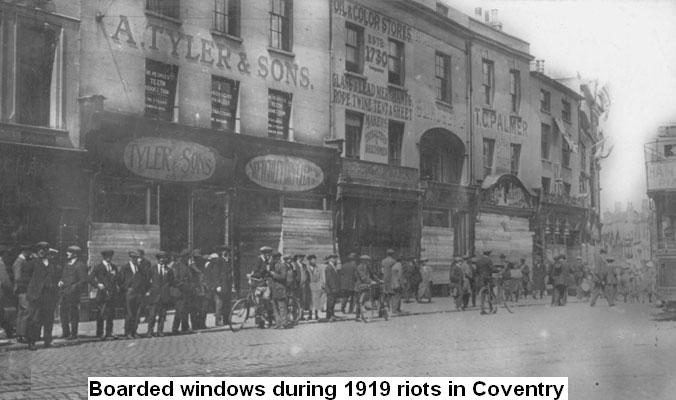|
morgana
the secret garden |
1 of 14
Fri 16th Dec 2011 11:36pm
Not sure if you've already had this bit of history
Riots over the price of bread and the inclosure of common land were frequent. Between 1370 and 1422 the city annals record seven occasions upon which 'the commons arose', two of them involving throwing loaves at the mayor. The part played by Coventry in the Peasants' Revolt is obscure. John Ball was captured in Coventry but his presence there was probably due to the fact that he seems to have had relatives in the town, rather than to the status of Coventry as a revolutionary centre. Coventry in1381 lacked the motives both of the peasant and urban rebels. Half a century earlier the priory might have been sacked. A century later, when the city oligarchy had become entrenched and when there was a leader and a substantial mob with grievances, there might have been an uprising. The Laurence Saunders affair, which lasted for more than two decades (c.1469-96), did provide an explosive situation. Saunders himself was an instinctive rebel. He asserted that the people would never have justice until 'we have striken off the heads of three or four of these churls' heads that rule us'. The inclosure of common lands had excited feelings of grievance for more than a century. But the situation in the 1490s was aggravated by a number of factors. Verses nailed to the door of St. Michael's in 1495 expressed a widespread feeling that the oligarchy was turning into a tyranny. They referred to leet orders to confine the cloth trade to the Drapery, to enforce payment for apprenticeship, and to restrict the Lammas riding, from which they concluded 'this city should be free and now is bond'. Resentment against the rich rulers of the city was fostered by Lollard beliefs about social equality. Coventry had a considerable reputation as a Lollard centre, especially during this period, and schemes for the disendowment of the church might well have been extended to include over-rich merchants. The authorities were especially alarmed by the presence of 'vagabonds and idle persons' among the Coventry commons and throughout the 15th century the city government had tried to enforce the royal decrees against livery and maintenance. |
| Local History and Heritage - Coventry riots | |
|
K
Somewhere |
2 of 14
Sat 17th Dec 2011 10:43am
I know there were riots in 1919 (I'll have to read up on them), but my parents spoke about "food riots" in 1935 in Coventry, but I can't find anything about them. Does anyone have any info? |
| Local History and Heritage - Coventry riots | |
|
heritage
Bedworth |
3 of 14
Sat 17th Dec 2011 4:27pm
Coventry certainly had riots in 1831, 1882 and 1919. I have never heard of food riots in 1939 but will see what I can find.

 |
| Local History and Heritage - Coventry riots | |
|
K
Somewhere |
4 of 14
Sat 17th Dec 2011 7:08pm
It was 1935 (not '39). Roughly coincided with the Jarrow food march. |
| Local History and Heritage - Coventry riots | |
|
Midland Red
|
5 of 14
Sat 7th Jul 2012 1:18pm
This makes interesting reading - a postcard sent from Coventry in 1908, referring to a dispute at Humber which resulted in physical violence!
 |
| Local History and Heritage - Coventry riots | |
|
Baz
Coventry |
6 of 14
Mon 9th Jul 2012 9:20pm
Is this part of or to do with the 1919 riots ? 
Always looking forward to looking at the past.
|
| Local History and Heritage - Coventry riots | |
|
LesMac
Coventry |
7 of 14
Tue 10th Jul 2012 10:18am
The shop netween A Tyler and T Palmer has the word colour spelt the American way.
Where was this photograph taken? Looks like The Burges to me. Les |
| Local History and Heritage - Coventry riots | |
|
TonyS
Coventry |
8 of 14
Tue 10th Jul 2012 1:52pm
Great photo Baz! |
| Local History and Heritage - Coventry riots | |
|
Baz
Coventry |
9 of 14
Tue 10th Jul 2012 9:33pm
Does anyone know about the Stoke Heath rent strikers. I have a copy of a photo that shows a number of people holding a banner that says "Stoke Heath Rent Strikers, Ask you to Support us, as we are supporting all tenants."
I don't know the year or what it was about. Anyone? Always looking forward to looking at the past.
|
| Local History and Heritage - Coventry riots | |
|
TonyS
Coventry |
10 of 14
Tue 10th Jul 2012 10:27pm
I'd not heard of this before, but the strikers are mentioned in the last three paragraphs at the very bottom of the page in this article - Stoke Heath rent strike
|
| Local History and Heritage - Coventry riots | |
|
Ghengis Smith
Ireland |
11 of 14
Tue 10th Jul 2012 11:26pm
On 10th Jul 2012 10:18am, LesMac said:
The shop netween A Tyler and T Palmer has the word colour spelt the American way.
Where was this photograph taken? Looks like The Burges to me.Les
I think the shop between Tyler's & Palmer's is Astleys. Don't look around to find the sound that's right beneath your feet
|
| Local History and Heritage - Coventry riots | |
|
PhiliPamInCoventry
Holbrooks |
12 of 14
Sat 14th Jul 2012 11:46am
Hi all |
| Local History and Heritage - Coventry riots | |
|
TonyS
Coventry |
13 of 14
Sat 14th Jul 2012 12:35pm
On 14th Jul 2012 11:46am, PhiliPamInCoventry said:
ps. I dont know if the act still exists as a new act of unlawful assembly is what we have now.
Hi Philip, The Riot Act is indeed still listed under the Public Order Act 1986, but most "altercations" these days come under Section 4 or 5 (using threatening behaviour or behaviour likely to cause distress or alarm) - The Riot Act is Section 1 of the same POA.
It appears that there was an intention in the 1986 Act to abolish the common law offences of riot, rout, unlawful assembly and affray - so it all gets a bit confusing at that point! |
| Local History and Heritage - Coventry riots | |
|
DBC
Nottinghamshire |
14 of 14
Sat 14th Jul 2012 11:04pm
According to the "Coventry We Have Lost" book the 1919 riots "broke out in the city centre as it was thought that some of the larger shops were German owned" and shows the shop of Salmon and Glucksteine in Broadgate with its windows boarded up. I don't know if that statement is true or not. I know that shops with German names were damaged by protesters during the war, but I find it strange this was still occurring after the war had ended. |
| Local History and Heritage - Coventry riots | |
Website & counter by Rob Orland © 2024
Load time: 657ms